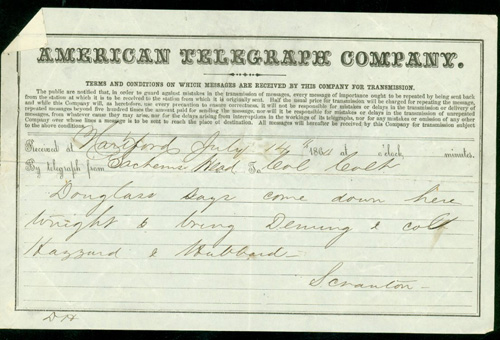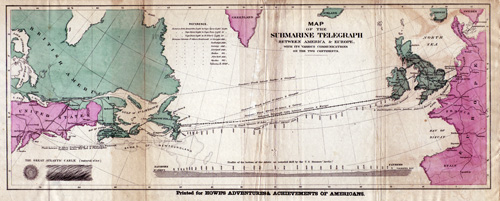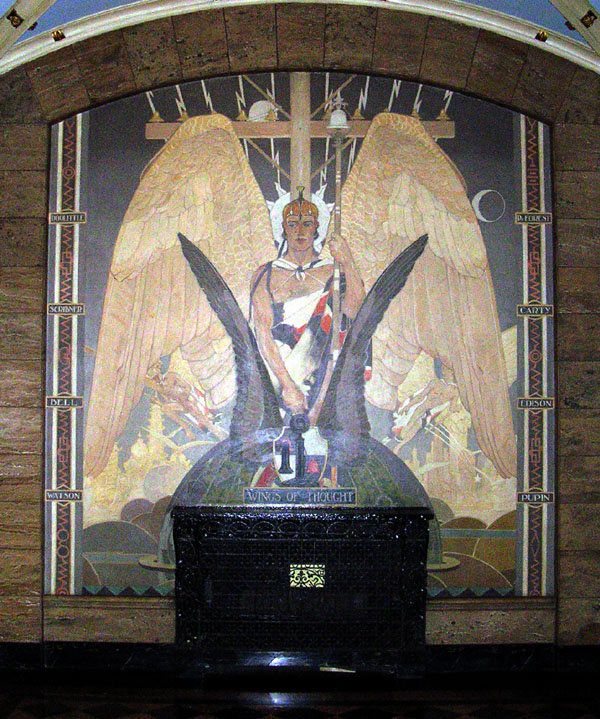Telecommunications in Colorado
1843–1863







In 1858 a cable laid on the Atlantic Ocean floor sent telegraph messages as far as Europe.
1870s decoded and delivered telegram.
Look at the dots and dashes that represent letters of the alphabet. Each letter has a code different from any other letter in the alphabet.
To send the letter "A," you would press the lever once very quickly, pause, then press the lever and hold a second longer.
A quick tap of the telegraph lever sends a dot. Pressing the lever down for a second transmits a dash. Each letter must be spelled out to send a message. Pause for a couple of seconds before pressing the lever to transmit the second letter. This helps the person receiving your message translate it correctly.
To send an SOS distress message, tap the lever three times to send three dots for the S, pause, then press the lever for a second, let go, then press again for another second, let go, and press a third time for another second; this will send an O. Finally, repeat the method you used for the S, and you've sent an SOS.
In 1843 Samuel Morse invented the telegraph—the first way telecommunications helped people's thoughts fly farther and faster.
Telegraph arrives in Denver
The telegraph came to Denver in 1863. The Rocky Mountain News, a long-time Denver newspaper, received news reports by telegraph. By 1870 railroads dispatched trains by telegraph.
The telegraph came to Denver in 1863. The Rocky Mountain News, a long-time Denver newspaper, received news reports by telegraph. By 1870 railroads dispatched trains by telegraph.
What was different from now?
* In 2011 dollars, the $9 cost would be $155 because the worth of the dollar has changed.
How much would your monthly bill be if you paid $155 per text message?
|
10-word message Denver-New York |
1863 telegraph |
2011 smart phone text |
|---|---|---|
| Cost | $9* | About 2 cents |
| Potential customers | 5,000 | 2.9 million |
| Delivery time | 1-3 days | instant |
| Transmission speed | 150 bits per second | 14 trillion bits per second |
* In 2011 dollars, the $9 cost would be $155 because the worth of the dollar has changed.
How much would your monthly bill be if you paid $155 per text message?
Online Exhibits
Telecommunications in Colorado

Allen Tupper True Mural, The Wings of Thought (THG file photo)
Throughout history, human beings have had an innate desire to communicate. This exhibit features a timeline from face-to-face communications of the mid-19th century to today’s instant, global communications, and invites the viewer to imagine what it must have been like to wait weeks or months for news from back home.
Using Allen True’s Wings of Thought mural as a motif, the exhibit highlights documents, directories, and photographs from Telecommunications History Group archives. This online exhibit is based on a 2011 THG exhibit at the Denver Public Library.
Note: Because the exhibit is based on a physical original, it doesn't currently work on a mobile phone in portrait mode (and will look very small in landscape as well). Please view on a tablet or larger device. We're working to get a version of this exhibit to be mobile-friendly.
